For your home succulent collection, consider reliable LED grow lights like the Spider Farmer SF1000 or GE LED Grow Light Bulb. You'll want full-spectrum capabilities that provide both blue light (400-500nm) for growth and red light (600-700nm) for flowering. Position your light 10-12 inches above plants, aiming for 300-800 lumens per square foot. Keep your setup running 12-14 hours daily using a timer. Understanding proper light placement and monitoring will guarantee your succulents thrive.
Understanding LED Light Spectrum Benefits for Succulents
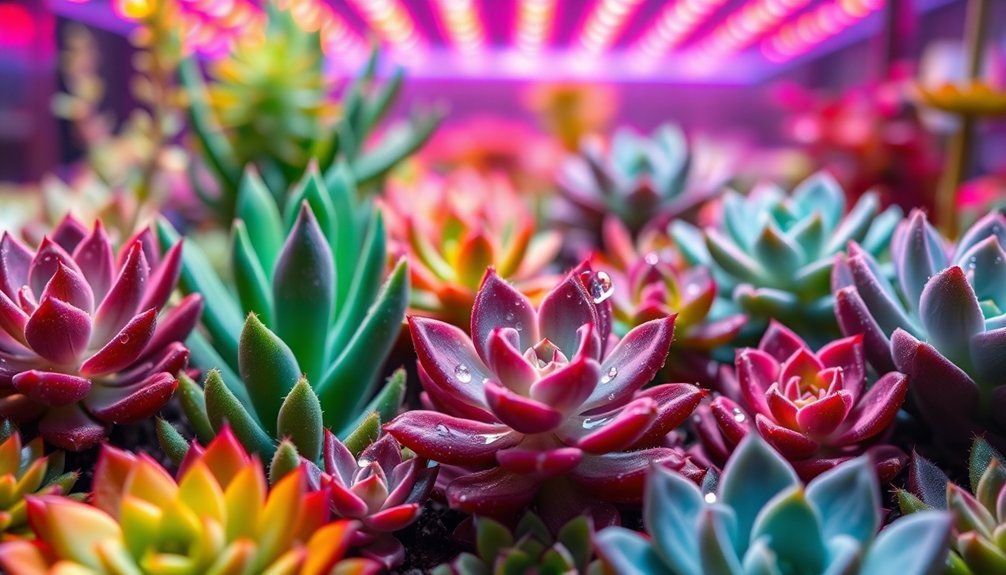
When it comes to growing healthy succulents indoors, understanding LED light spectrum benefits can dramatically improve your plants' growth and development. Your succulents need specific light wavelengths to thrive, and LED grow lights deliver exactly what they need.
Full spectrum LED lights provide essential blue light (400-500nm) that drives vegetative growth, while red light (600-700nm) promotes flowering and fruiting.
Blue and red wavelengths in full spectrum LEDs deliver exactly what succulents need – vegetative growth, flowering, and optimal development.
You'll appreciate how these lights offer customizable spectrum options, letting you adjust the light output to match your succulents' growth stages. The energy efficiency of LEDs means you'll get more light per watt while keeping your electricity bills low.
Plus, since they generate minimal heat, you can position them closer to your plants for ideal growing conditions without risking burn damage. This precise control over light exposure guarantees your succulents receive perfect growing conditions year-round.
Optimal Light Intensity and Coverage Requirements
When selecting an LED grow light for your succulents, you'll need to understand the relationship between PAR (Photosynthetically Active Radiation) levels and coverage area to guarantee ideal growth.
Your succulents require 300-800 lumens per square foot, with the light positioned 10-12 inches away to achieve the right balance of intensity and spread.
To maximize light distribution, consider how your chosen LED's beam angle affects coverage, as wider angles typically serve multiple plants better but may reduce intensity at greater distances.
Measuring PAR Light Levels
Understanding PAR light levels is vital for providing your succulents with ideal growing conditions. PAR (Photosynthetically Active Radiation) measures light intensity within the 400-700 nanometer range, which is essential for succulent growth.
To guarantee your plants thrive, you'll want to maintain PAR values between 200-400 µmol/m²/s at the canopy level.
You'll need a PAR meter to accurately measure your grow lights' output. This tool helps you adjust the distance from light source and intensity to match your succulents' needs.
Remember to check that light coverage spreads evenly across your growing area to prevent dark spots. Monitor PAR levels regularly, as they can change due to environmental factors.
Distance Vs Coverage Area
Now that you can measure your grow lights' PAR levels, finding the right distance between your lights and succulents becomes the next key factor for success.
The ideal distance for LED grow lights typically ranges from 6 to 12 inches above your plants, but you'll need to adjust distance based on your specific light's intensity.
Positioning your lights closer, around 6 inches, concentrates light intensity on a smaller coverage area, perfect when you're growing just a few succulents.
If you're growing multiple plants, placing lights at 12 inches provides wider coverage but may require longer exposure times for ideal plant growth.
Watch your succulents' response carefully – if they're stretching upward, move the lights closer; if leaves show signs of scorching, increase the distance.
Regular monitoring helps you find the sweet spot for your setup.
Top-Rated LED Grow Light Models for Small Collections
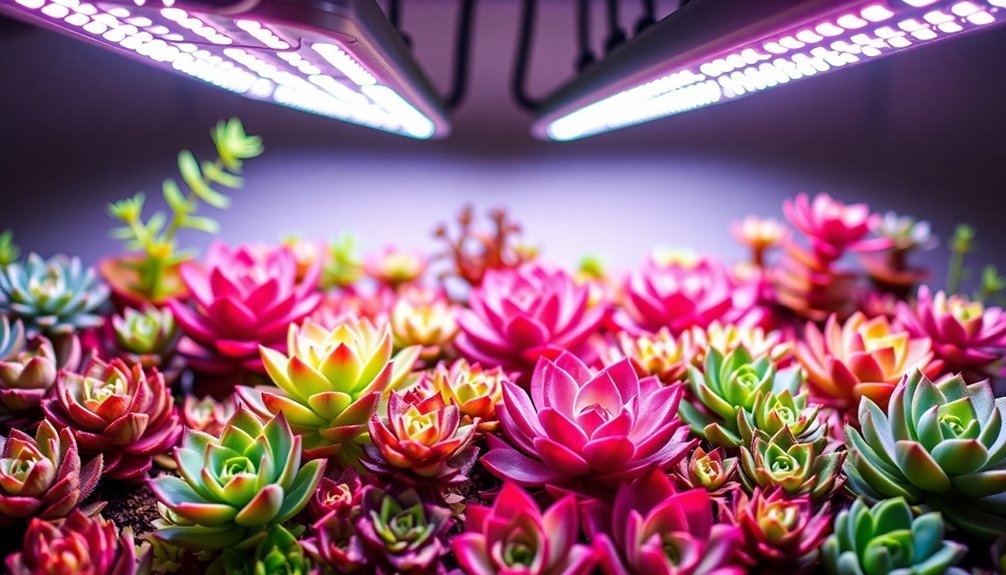
Since most succulent enthusiasts start with small collections, choosing the right LED grow light is essential for healthy plant growth. The Spider Farmer SF1000 stands out as a top performer, offering full-spectrum grow light capabilities with exceptional energy efficiency and safe heat management for your succulents.
For versatile lighting control, you'll find the LBW Grow Light's adjustable brightness and timer features perfect for different growth stages.
The Leoter Grow Light's four flexible arms provide excellent coverage for varying plant heights, while its dimming options let you customize light intensity.
If you're seeking an affordable option, the GE LED Grow Light Bulb fits standard fixtures and effectively supports indoor plants.
Remember to position any of these lights about 12 inches above your succulents to achieve ideal growing conditions without risking heat damage.
Setting Up Your LED Growing Station
With your LED grow light selected, creating an efficient growing station requires careful attention to several key factors. Position your LED grow light about 12 inches above your succulents to guarantee ideal growth while preventing heat damage.
To maximize light distribution, add reflective surfaces around your setup, which will help spread light evenly across your collection.
Set up a digital timer to maintain consistent light exposure, programming it for 12-14 hours daily to replicate natural sunlight conditions.
You'll need to monitor plants regularly for signs of stress, such as stretching or color changes, and adjust the light intensity accordingly.
Remember that your succulents need a full spectrum range of 3000K to 6500K for healthy development through all growth stages. Make adjustments to height and duration based on your plants' responses.
Proper Light Positioning and Distance Guidelines
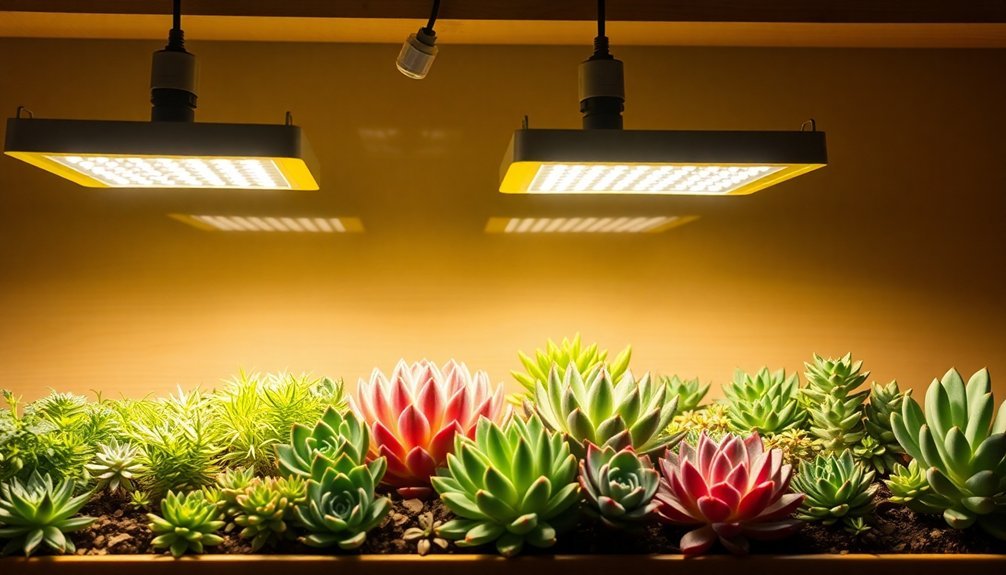
Ideal light positioning stands as a critical factor in successful succulent growth under LED lights. Your succulents need grow lights at specific distances to thrive – typically 12 inches for mature plants and 6-10 inches for smaller varieties.
Proper LED light placement is essential – position mature succulents at 12 inches and smaller plants at 6-10 inches for optimal growth.
To guarantee balanced growth, you'll need to regularly adjust distance and monitor plants' response to light intensity.
- Position LED grow lights 12 inches away from mature succulents to prevent heat damage while maintaining peak brightness.
- Keep lights 6-10 inches from smaller or young plants to provide adequate intensity for healthy development.
- Adjust your light distance guidelines based on growth stages, moving closer during active periods.
- Rotate plants weekly for even exposure, preventing stretching or leaning.
Watch for signs that your succulents aren't getting proper light positioning – if they stretch toward the light source, move the fixture closer.
Seasonal Adjustments for Light Duration
Beyond proper light positioning, understanding seasonal light duration keeps your succulents thriving year-round.
During winter months, you'll need to provide your indoor succulents with 12-14 hours of grow lights daily to compensate for shorter natural daylight, preventing leggy growth.
As spring arrives and days lengthen naturally, adjust your growing conditions by reducing light exposure to 10-12 hours. You'll want to make these changes gradually to help your plants adapt smoothly to the seasonal changes.
Keep a close eye on your succulents' response and growth patterns during these shifts.
Monitor your plants' appearance and adjust light duration accordingly – if they're stretching, increase exposure time; if they show signs of stress, reduce it.
These thoughtful adjustments guarantee peak health and maintain your succulents' compact, vibrant appearance throughout the year.
Monitoring Plant Response to LED Lighting
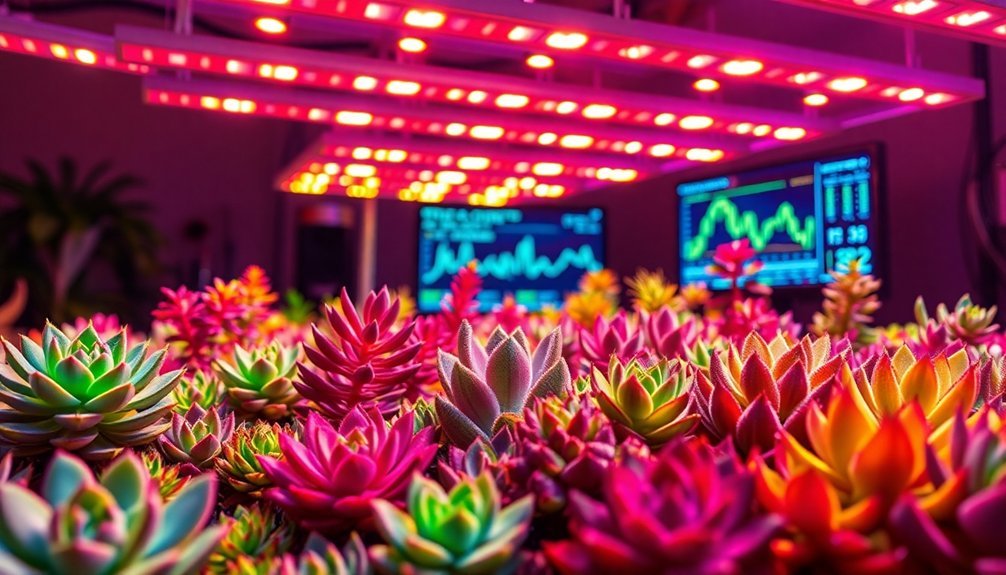
Watch your succulents closely for signs of light stress, including stretched stems, faded leaves, or brown spots that indicate improper LED light exposure.
You'll need to adjust your grow light's height daily, maintaining a 10-12 inch distance from your plants while monitoring their response to the light intensity.
If you notice any signs of burning or etiolation, quickly modify the light's position until your succulents display healthy, compact growth with vibrant coloring.
Signs of Light Stress
Recognizing signs of light stress in your succulents is essential for maintaining their health under LED grow lights.
You'll need to carefully monitor growth patterns and adjust light conditions accordingly.
Watch for leaf discoloration, like yellowing or browning, which indicates excessive light intensity. If you notice your plants becoming elongated or stretched, they're likely not getting enough light exposure.
Key signs of light stress to watch for:
- Etiolation (stretching) – indicates insufficient light placement
- Scorched leaf edges – suggests your plants are too close to the LED grow light
- Yellowing or browning leaves – signals excessive light intensity
- Leaf drops or wilting – shows imbalanced light exposure
Remember to adjust your light duration to 12-14 hours daily and maintain proper distance between your plants and LED lights to prevent stress.
Adjusting Light Height Daily
Maintaining proper LED light height plays a direct role in preventing the stress symptoms we've discussed. You'll need to keep your LED grow lights between 6 to 12 inches above your succulents for ideal growth.
Watch your plants closely – if they're stretching upward, lower the lights, but if you notice leaf burn, raise them higher.
As your succulents grow, you'll need to adjust the height regularly to maintain this ideal distance.
Don't forget to rotate your plants weekly, ensuring all sides receive equal light exposure.
Pay attention to how your plants respond to different heights, and make small adjustments accordingly.
For smaller collections, you can position lights closer for intensity, while larger setups may require higher placement for broader coverage.
Energy Efficiency and Cost Analysis
When considering LED grow lights for your succulents, the long-term financial benefits are substantial. These energy-efficient fixtures consume 50-60% less power than traditional options while delivering ideal light output for succulent growth.
You'll notice immediate savings on your electricity bill, as a 100-watt LED only costs about $1.20 per month to operate for 12 hours daily.
- LED grow lights typically last up to 50,000 hours, reducing replacement frequency and maintenance costs.
- With 100-150 lumens per watt, you'll get maximum light efficiency for your energy investment.
- Lower energy usage translates to approximately 60% reduction in operating costs.
- You can expect a return on investment within one year due to cost-effective operation.
These features make LED grow lights an economically smart choice for maintaining your indoor succulent collection while keeping utility costs manageable.
Combining Natural and LED Light Sources
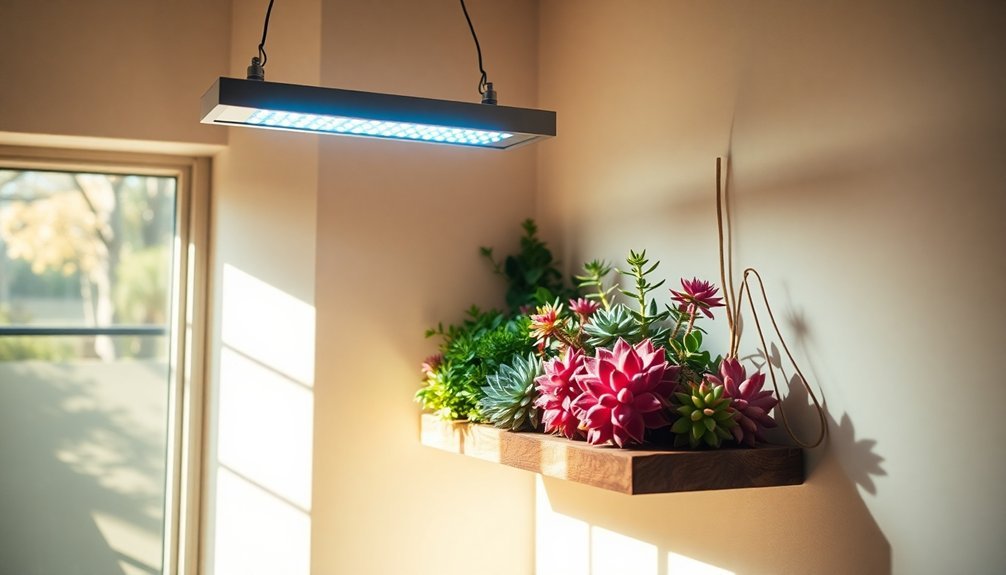
Beyond the energy savings of LED grow lights, combining them with natural sunlight creates an excellent growing environment for your succulents.
You'll want to aim for at least 12 hours of total light exposure per day, using full-spectrum LED lights with 5000K to 6500K color temperature to replicate the conditions where succulents thrive.
Position your grow lights 6 to 12 inches above your plants to achieve ideal light intensity without causing harm.
When supplementing natural sunlight with artificial lighting, use timers for LED lights to maintain consistent exposure throughout the day.
Remember to monitor your succulents' response to this combined lighting setup, and adjust the duration of LED exposure as needed.
This strategic approach guarantees your plants receive the well-rounded light spectrum they need for healthy growth while maximizing the benefits of both light sources.
Frequently Asked Questions
What LED Grow Lights Are Best for Succulents?
You'll get great results with Spider Farmer SF1000 or LBW Grow Lights. Place them 10-12 inches above your succulents, run them 12-14 hours daily, and guarantee they provide 300-800 lumens per square foot.
Can LED Grow Lights Burn Succulents?
Yes, LED grow lights can burn your succulents if placed too close. You'll want to keep them 6-12 inches away and use adjustable settings. Monitor your plants for signs of stress or leaf burn.
How Many Lumens Do Succulents Need?
You'll need 300-800 lumens per square foot for your succulents. Sun-loving varieties like Echeveria require closer to 800 lumens, while low-light tolerant types like Haworthia can thrive with just 300 lumens.
What Kind of Light Do Succulent Plants Like?
Your succulents need bright, direct sunlight or full-spectrum lighting with 5000K-6500K color temperature. They'll thrive with both red and blue wavelengths for 6+ hours daily, whether it's natural light or artificial grow lights.
In Summary
You'll find LED grow lights are an excellent investment for your indoor succulent collection, providing the perfect spectrum and intensity for healthy growth year-round. By selecting the right model, positioning it correctly, and making seasonal adjustments, you're ensuring your plants thrive. Combined with natural light when possible, LED lighting offers an energy-efficient solution that'll keep your succulents happy while keeping your electricity costs manageable.

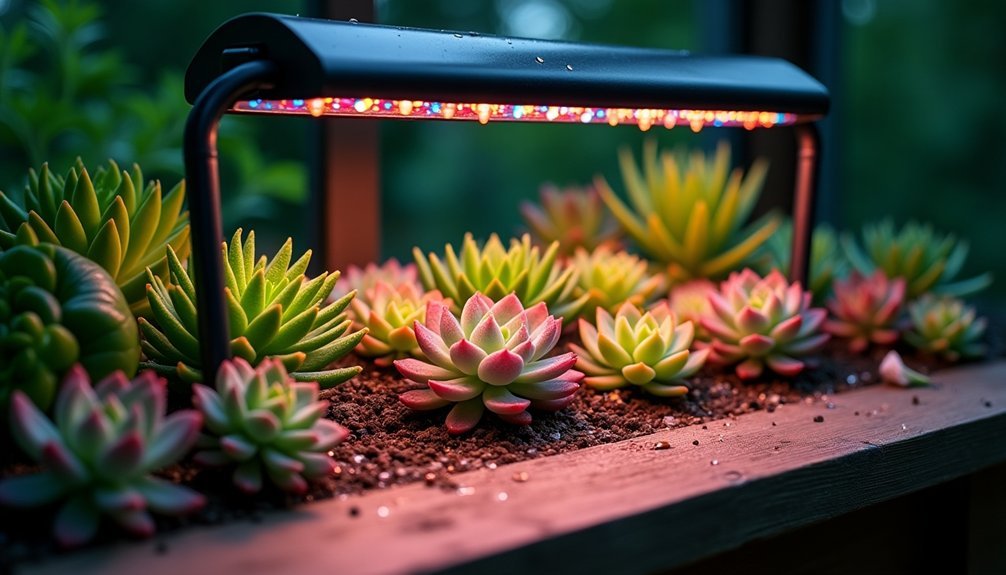



Leave a Reply